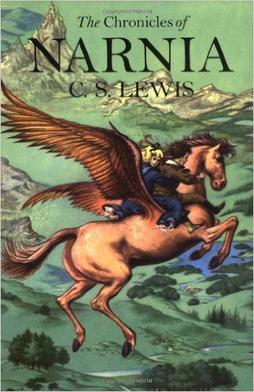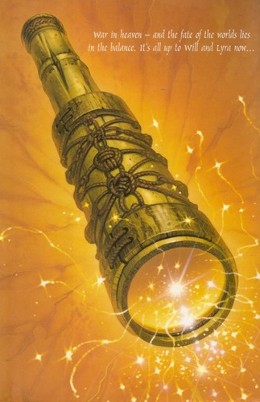
The Chronicles of Narnia is a series of seven high fantasy novels by British author C. S. Lewis. Illustrated by Pauline Baynes and originally published between 1950 and 1956, The Chronicles of Narnia has been adapted for radio, television, the stage, film and video games. The series is set in the fictional realm of Narnia, a fantasy world of magic, mythical beasts and talking animals. It narrates the adventures of various children who play central roles in the unfolding history of the Narnian world. Except in The Horse and His Boy, the protagonists are all children from the real world who are magically transported to Narnia, where they are sometimes called upon by the lion Aslan to protect Narnia from evil. The books span the entire history of Narnia, from its creation in The Magician's Nephew to its eventual destruction in The Last Battle.

The Magician's Nephew is a fantasy children's novel by C. S. Lewis, published in 1955 by The Bodley Head. It is the sixth published of seven novels in The Chronicles of Narnia (1950–1956). In recent editions, which sequence the books according to Narnia history, it is volume one of the series. Like the others, it was illustrated by Pauline Baynes whose work has been retained in many later editions. The Bodley Head was a new publisher for The Chronicles, a change from Geoffrey Bles who had published the previous five novels.

The Lion, the Witch and the Wardrobe is a fantasy novel for children by C. S. Lewis, published by Geoffrey Bles in 1950. It is the first published and best known of seven novels in The Chronicles of Narnia (1950–1956). Among all the author's books, it is also the most widely held in libraries. Although it was originally the first of The Chronicles of Narnia, it is volume two in recent editions that are sequenced by the stories' chronology. Like the other Chronicles, it was illustrated by Pauline Baynes, and her work has been retained in many later editions.

"Hansel and Gretel" is a German fairy tale collected by the Brothers Grimm and published in 1812 as part of Grimm's Fairy Tales. It is also known as Little Step Brother and Little Step Sister.

Howl's Moving Castle is a fantasy novel by British author Diana Wynne Jones, first published in 1986 by Greenwillow Books of New York. It was a runner-up for the annual Boston Globe–Horn Book Award, and won the Phoenix Award twenty years later. It was adapted into a critically acclaimed 2004 animated film of the same name, which was nominated for the Academy Award for Best Animated Feature.
Elizabeth George Speare was an American writer of children's books, best known for historical novels including two Newbery Medal winners. She has been called one of America's 100 most popular writers for children and some of her work has become mandatory reading in many schools throughout the nation. Since her books have sold so well she is cited as one of the Educational Paperback Association's top 100 authors.

The Amber Spyglass is the third novel in the His Dark Materials trilogy by Philip Pullman. Published in 2000, it won the 2001 Whitbread Book of the Year award, the first children's novel to do so. It was named Children's Book of the Year at the 2001 British Book Awards, and was the first children's book to be longlisted for the Booker Prize.

The Witches is a children's dark fantasy novel by British author Roald Dahl. The story is set partly in Norway and partly in England, and features the experiences of a young English boy and his Norwegian grandmother in a world where child-hating societies of witches secretly exist in every country. The witches are ruled by the vicious and powerful Grand High Witch, who arrives in England to organize her plan to turn all of the children there into mice.

The Borrowers is a children's fantasy novel by the English author Mary Norton, published by Dent in 1952. It features a family of tiny people who live secretly in the walls and floors of an English house and "borrow" from the big people in order to survive. The Borrowers also refers to the series of five novels including The Borrowers and four sequels that feature the same family after they leave "their" house.

Professor Digory Kirke is a fictional character from C. S. Lewis' fantasy series The Chronicles of Narnia. He appears in three of the seven books: The Lion, the Witch and the Wardrobe, The Magician's Nephew, and The Last Battle.
Chiquititas is a children's musical Argentine soap opera, created and produced by Cris Morena. It starred Morena's daughter Romina Yan and Agustina Cherri.

The Witch of Blackbird Pond is a children's novel by American author Elizabeth George Speare, published in 1958. The story takes place in late 17th-century New England. It won the Newbery Medal in 1958.

The Black Bull of Norroway is a fairy tale from Scotland. A similar story titled The Red Bull of Norroway first appeared in print in Popular Rhymes of Scotland by Robert Chambers in 1842. A version titled The Black Bull of Norroway in the 1870 edition of Popular Rhymes of Scotland was reprinted in an Anglicised version by Joseph Jacobs in his 1894 book More English Fairy Tales.
The Brown Bear of Norway is an Irish fairy tale collected by Patrick Kennedy which appeared in his Legendary Fictions of the Irish Celts (1866). It was later included by Andrew Lang in his anthology The Lilac Fairy Book (1910), though Lang misattributed his source as West Highland Tales.
"The Three Little Birds" is a German fairy tale collected by the Brothers Grimm, tale number 96. The story is originally written in Low German. It is Aarne-Thompson type 707, the dancing water, the singing apple, and the speaking bird. The story resembles Ancilotto, King of Provino, by Giovanni Francesco Straparola, and The Sisters Envious of Their Cadette, the story of the 756th night of the Arabian Nights.

White-Bear-King-Valemon is a Norwegian fairy tale. The tale was published as No. 90 in Asbjørnsen and Moe's Norske Folke-Eventyr. Ny Samling (1871). George Webbe Dasent translated it for his Tales from the Fjeld.

Teeny-Tiny and the Witch-Woman is a story written by Barbara K. Walker and illustrated by Michael Foreman based on an old Turkish folk tale. The story was first published in 1975 by Pantheon Books and an animated short based on the story was produced by Weston Woods on May 31, 1980, directed by Gene Deitch.
The Orphan's Tales is a fantasy series by Catherynne M. Valente with illustrations by Michael Kaluta. The two novels of the series, In the Night Garden and In the Cities of Coin and Spice, are in turn split into two books apiece. While three of these four books begin with a story told by the same young woman, her stories branch out into other stories, often narrated by a completely different character.

Scarlet Witch is a character appearing in American comic books published by Marvel Comics. Created by writer Stan Lee and artist Jack Kirby, the character first appeared in The X-Men #4 in the Silver Age of Comic Books. Originally said to have the ability to alter probability, the Scarlet Witch has been depicted as a powerful sorceress since the 1980s and on occasion has become powerful enough to alter reality by tapping into greater energy sources.
The Bird that Spoke the Truth is a New Mexican folktale. It is related to the motif of the calumniated wife and classified in the international Aarne-Thompson-Uther Index as type ATU 707, "The Three Golden Children".














